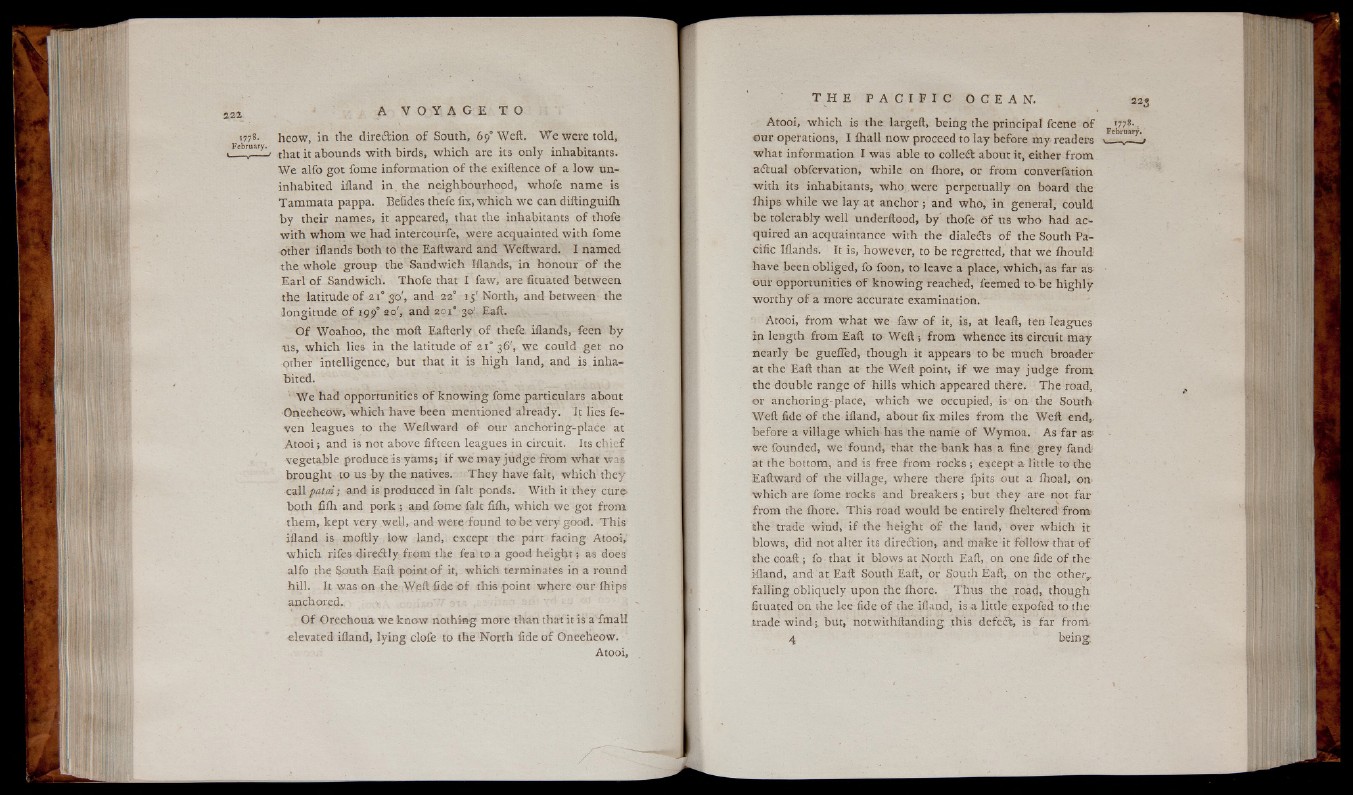
1778- heow, in the direction o f South, 69° Weft. We were told,
• ‘ r“a y~' that it abounds with birds, w h ich are its only inhabitants.
We alfo got fome information o f thé exiftence o f a low uninhabited
ifland in , the neighbourhood, whofe name is
Tammata pappa. Befides thefe fix, w h ich w e can diftinguiih
b y their names, it appeared, that the inhabitants o f thofe
w ith whom w e had intercourfe, were acquainted w ith fome
other iflands both to the Eaftward and Wëftward. I named
th e whole group the Sandwich Iflands, in honour o f the
Earl o f Sandwich. Thofe that I faw, are fituated between
the latitude o f 21° 30', and 22° 1 5 'North, and between the
lon g itu d e o f 199° ao', and 20 / 30' Eaft.
O f Woahoo, the moft Eafterly o f thefe iflands, féen b y
us, w hich lies in the latitude o f 21° 36', we could g e t no
other intelligence, but that it is h ig h land, and is inhabited.
We had opportunities o f k n ow in g fome particulars about
Oneeheow, which have been mentioned already. It lies fe-
ven leagues to the Weftward o f our anchoring-place at
Atooi ; and is not above fifteen leagues in circuit. Its ch ie f
vegetable produce is yams; i f we may ju d g e from what was
brou ght to us b y the natives. T h e y have fait, w hich they
call pat ai ; and is produced in fait ponds. With it they cure,
both fiih and p o rk ; and fonte fait fifli, which we got from
them, kept ve ry w ell, and were found to be v e ry good. This
ifland is moilly low land, except the part facin g Atooi,
w hich rifes diretftly from the fea to a good h e ig h t ; as does
alfo the South Eaft point o f it, which terminates in a round
hill. It was on the Weft fide o f this point where our fhips
anchored. -,
O f Oreeboua we kn ow nothing more than that it is a fmall
elevated ifland, ly in g clofe to the North fide o f Oneeheow.
Atooi,
Atooi, w hich is the largeft, being the principal fcene o f
ou r operations, I fliall now proceed to la y before m y readers
w hat information I was able to co lle il about it, either from
adlual obfervation, while on Chore, or from converfation
w ith its inhabitants, who,,were perpetually on board the
fhips w h ile w e la y at a n ch o r ; and who, in general, could
be tolerably well underftood, by' thofe o f us who had acquired
an acquaintance with the dialedts o f the South Pacific
Iflands. It is, however, to be regretted, that we Ihould
have been obliged, fo foon, to leave a place, w hich, as far as
our opportunities o f kn ow in g reached, feemed to be h ig h ly
worthy o f a more accurate examination.
Atooi, from what we faw o f it, is, at leaft, ten leagues
in length from Eaft to W e ft ; from when ce its circuit may
nearly be guefled, though it appears to be much broader
at the Eaft than at the Weft point, i f w e may ju d g e from
the double range o f hills w hich appeared there. The road,
or anchoring-place, which w e occupied, is on the South
Weft fide o f the ifland, about fix miles from the Weft end,
before a village w hich has the name o f Wymoa. As far as1
we founded, we found, that the bank has a fine grey fand
at the bottom, and is free from rocks ; except a little to the
Eaftward o f the village, where there fpits out a ihoal, on.
w hich are fome rocks and b re a k e r s ; but they are not fa r
from the ihore. T h is road would be entirely iheltered from
the trade wind, i f the height o f the land, over which it
blows, did not alter its direction, and make it follow that o f
the coaft ; fo that it blows at North Eaft, on one fide o f the
ifland, and at Eaft South Eaft, or South Eaft, on the other,,
fa llin g obliquely upon the ihore. T h u s the road, though
fituated on the lee fide o f the. ifland, is a little expoied to the
trade w in d ; but, notwithftanding th is defeft, is far from
4 being.
*77*-.
February.